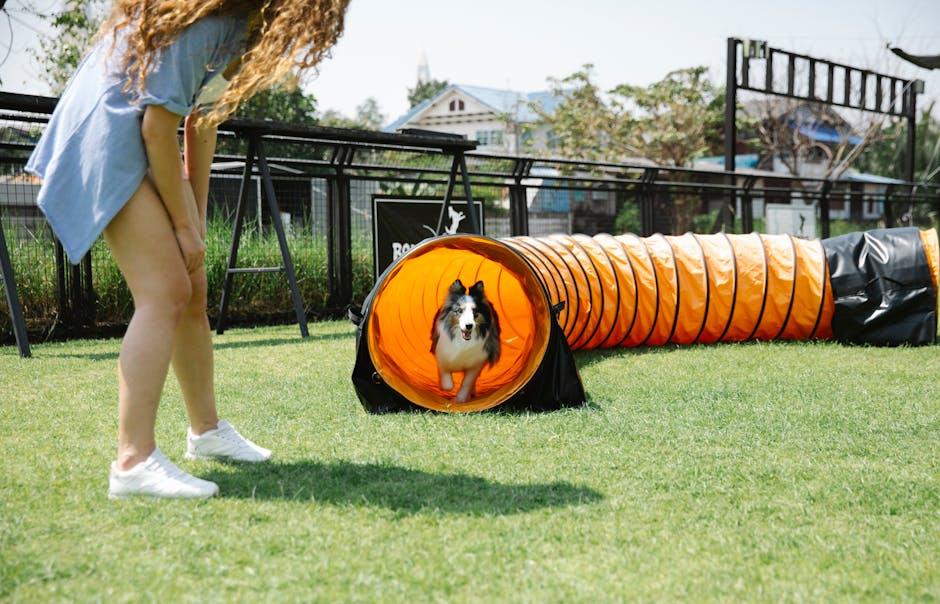Introducing a dog to the world of therapy work is a journey filled with compassion, dedication, and the promise of spreading joy and comfort. Whether it’s a wagging tail greeting hospital patients or a gentle nuzzle offering solace to a child, therapy dogs have a unique ability to touch lives in profound ways. In this guide, we’ll explore the steps to transform your furry companion into a certified therapy dog, focusing on the essential training techniques, temperament requirements, and the certification process. With patience and love, you and your dog can embark on a rewarding path that enriches not only the lives of those you visit but your own as well. Join us as we delve into the heartwarming world of therapy dog training, where every lesson learned brings us closer to making a difference.
Building a Strong Foundation with Basic Obedience
Establishing a foundation of basic obedience is crucial for dogs destined for therapy work. These dogs need to be reliable and responsive in a variety of settings. Begin with the essentials: sit, stay, come, heel, and leave it. Each command should be practiced consistently in different environments to ensure the dog can perform reliably, regardless of distractions.
- Sit: Encourage your dog to sit before meals, when meeting new people, or when you stop during a walk.
- Stay: Practice this command at increasing distances and durations, gradually introducing distractions to build your dog’s focus.
- Come: Use positive reinforcement to make returning to you a rewarding experience, essential for maintaining control in public spaces.
- Heel: Teach your dog to walk calmly by your side, fostering a sense of security and partnership.
- Leave it: Essential for ensuring your dog ignores distractions and remains focused on the task at hand.
Incorporate these commands into daily routines to reinforce good behavior and strengthen the bond between you and your dog. Consistent practice and positive reinforcement will help your dog become a confident and reliable therapy companion.

Creating a Calm and Nurturing Environment
To foster a serene setting conducive to training your dog for therapy work, it’s essential to focus on creating a space that is both soothing and supportive. Begin by choosing a quiet area of your home where distractions are minimal. This will help your dog to concentrate and feel at ease. Soft lighting, gentle music, and comfortable bedding can all contribute to a peaceful atmosphere.
- Consistency: Establish a regular routine to instill a sense of security.
- Positive Reinforcement: Use treats and praise to reward calm behavior.
- Safe Space: Provide a dedicated spot where your dog can retreat and relax.
Additionally, integrating calming scents like lavender or chamomile can enhance the environment. The goal is to cultivate a space where your dog feels safe and valued, enabling them to develop the empathy and calmness required for effective therapy work.

Understanding Canine Body Language and Signals
Recognizing and interpreting a dog’s body language is crucial in preparing them for therapy work. Dogs communicate through various signals, and understanding these can help in fostering a trusting relationship. Pay attention to the following key indicators:
- Tail Wagging: While often seen as a sign of happiness, the speed and position of the tail can indicate different emotions. A slow wag with the tail held high might signal alertness or confidence, whereas a low, quick wag can indicate nervousness.
- Ear Position: Ears that are perked up usually show curiosity or interest, while ears laid back against the head might indicate fear or submission.
- Eye Contact: Direct eye contact can be perceived as a challenge, whereas soft, blinking eyes can indicate relaxation and trust.
- Body Stance: A relaxed dog will have a loose and wagging body, whereas a tense or rigid stance may indicate stress or anxiety.
By observing these signals, you can better understand your dog’s feelings and adjust your training approach accordingly. This not only helps in building a strong bond but also ensures that the therapy sessions are beneficial for both the dog and the individuals they will help.

Incorporating Positive Reinforcement Techniques
Engaging your dog with positive reinforcement is a powerful way to nurture desired behaviors essential for therapy work. This approach focuses on rewarding good behavior rather than punishing the unwanted, creating a safe and encouraging environment for your furry friend. When your dog exhibits a behavior you want to encourage, such as sitting calmly or greeting a person gently, immediately reward them with a treat, verbal praise, or affection. This immediate response helps your dog associate the behavior with positive outcomes, making it more likely they will repeat it.
- Treats: Use small, tasty treats that your dog loves. Make sure they are easily consumable to keep the training session smooth.
- Verbal Praise: Use a warm, enthusiastic tone to convey your approval. Simple phrases like “Good job!” or “Well done!” can be very effective.
- Affection: Petting or gentle pats can be just as rewarding as treats for some dogs. Use this method if your dog responds well to physical affection.
Consistency is key in positive reinforcement. Regularly rewarding your dog for their efforts ensures that they understand what is expected of them and helps build a strong bond of trust and cooperation, laying a solid foundation for their future as a therapy dog.

